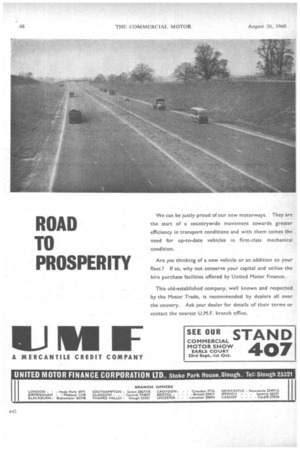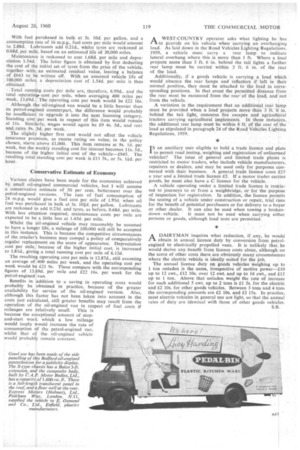ROAD TO PROSPERITY
Page 76

Page 77

If you've noticed an error in this article please click here to report it so we can fix it.
With fuel purchased in bulk at 3s. 10d. per gallon, and a consumption rate of 16 m.p.g., fuel costs per mile would amount to 2.88d. Lubricants add 0.21d., whilst tyres arc reckoned at 0.68d. per mile, based on an estimated life of 30,000 miles,
Maintenance is reckoned to cost 1.68d. per mile and depreciation 1.54d. The latter figure is obtained by first deducting the cost of the initial set of tyres from the price of the vehicle, together -with. an estimated residual value, leaving a balance of 1643 to be written off. With an assumed vehicle life of 100,000 miles, a depreciation cost of 1.54d. per mile is thus obtained.
Total running costs per mile are, therefore, 6.99d., and the total operatingcost per mile, when averaging 400 miles per week, 13.69d. The operating cost per week would be 122 16s.
Although the oil-engined van would be a little heavier than its petrol-engined counterpart, the difference would probably be insufficient to upgrade it into the next licensing category. Standing cost per week in respect of this item would remain at Hs. Similarly, wages would again be £9 4s. 3d., and rent and rates 9s. 3d per week.
The slightly higher first cost would not affect the vehicle insurance premium, as excess rating on value, in the policy chosen, starts above £1,000. This item remains at 9s. td, per week, but the weekly standing cost for interest becomes Ils. 5d., because of the higher initial cost of the vehicle-1945. The resulting total standing cost per week is £11 5s., or 5s. 13d. per hour.
Conservative Estimate of Economy
Various claims have been made for the economies achieved by small oil-engined commercial vehicles, but I will assume a conservative estimate of 50 per cent. betterment over the petrol-engined versions. The rate of fuel consumption of 24 m.p.g, would give a fuel cost per mile of 1.95d, when oil fuel was purchased in bulk at 3s. 101d, per gallon. Lubricants are reckoned to add 0.23d, and tyres, as before, 0.68d, per mile. With less attention required, maintenance costs per mile are expected to be a little less at 1.45d. per mile.
WhilSt the oil-engined vehicle may reasonably be assumed to have a longer life, a mileage of 100,000 will still be accepted in this instance. This is because the competitive circumstances of the retailer's business may compel a policy of comparatively regular replacement on the score of appearance. Depreciation cost per mile, because of the higher initial cost, is increased to 1.81d., giving a total running cost per mile of 6.12d.
The resulting operating cost per mile is 12.87d., still assuming an average of 400 miles per week, and the operating cost per week would be £21 9s. These compare with the corresponding figures of 13.69d, per mile and 122 16s. per week for the petrol-engined van.
Benefits in addition to a saving in operating costs would probably be obtained in practice, because of the greater availability for service of the oil-engined version. Also, although this factor has not been taken into account in the costs just calculated, still greater benefits may result from the operation of the oil-engined van in respect of fuel costs if mileages are relatively small. This is because the exceptional amount of stopand-start work which a low mileage would imply would increase the rate of consumption of the petrol-engined van, whilst that of the oil-cngined vehicle would probably remain constant.
AWEST-COUNTRY operator asks what lighting he has
to provide on his vehicle when carrying an overhanging load. As laid down in the Road Vehicles Lighting Regulations. 1959, a vehicle must carry a rear lamp to indicate lateral overhang where this is more than 1 ft Where a load projects more than 3 ft. 6 in. behind the tail lights a further rear lamp must be carried within 3 ft. 6 in. of the rear of the load.
Additionally, if a goods vehicle is carrying a load which would obscure the rear lamps and reflectors if left in their normal .position, they must be attached to the load in corresponding positions. In that event the permitted distance from the rear must be measured from the rear of the load, and not from the vehicle.
A variation in the requirement that an additional rear lamp must be provided when a load projects more than 3 ft. 6 in. behind the tail light, concerns fire escapes and agricultural tractors carrying agricultural implements. In these instances, the additional rear lamp must be within 6 ft. of the rear of the load as stipulated in paragraph 24 of the Road Vehicles Lighting Regulations, 1959.
I s an ancillary user eligible to hold a trade licence and plate to permit road testing, weighing and registration of unlicensed vehicles? The issue of general and limited trade plates is restricted to motor traders, who include vehicle manufacturers, repairers or dealers, and may be used only for purposes connected with their business. A general trade licence costs £25 a year and a limited trade licence £5. If a motor trader carries goods, he must also have a C licence for the vehicle.
A vehicle operating under a limited trade licence is restricted to journeys to or from a weighbridge, or for the purpose of inspection for registration. In addition, the licence permits the testing of a vehicle under construction or repair, trial runs for the benefit of potential purchasers or for delivery to a buyer or other dealer. it can also be used when towing a broken down vehicle. It must not be used when carrying either persons or goods, although load tests are permitted.
A DAIRYMAN inquires what reduction, if any, he would obtain in annual licence duty by conversion from petrolengined to electrically propelled vans. It is unlikely that he would derive any .benefit from licence costs alone, although on the score of other costs there are obviously many circumstances where the electric vehicle is ideally, suited for the job. The annual licence duty on goods vehicles weighing up to 1 ton unladen is the same, irrespective of motive power—£10 up to 12 cwt., £12 10s. over 12 cwt. and up to 16 cwt., and £15 up to 1 ton. Above that unladen weight the rate of increase for each additional 5 cwt. up to 2 tons is £1 5s. for the electric and £2 10s. for other goods vehicles. Between 3 tons and 4 tons the corresponding amounts are £2 10s. and £3 15s. In practice, most electric vehicles in general use are light, so that the annual rates of duty are identical with those of other goods vehicles. S.B.




















































































































